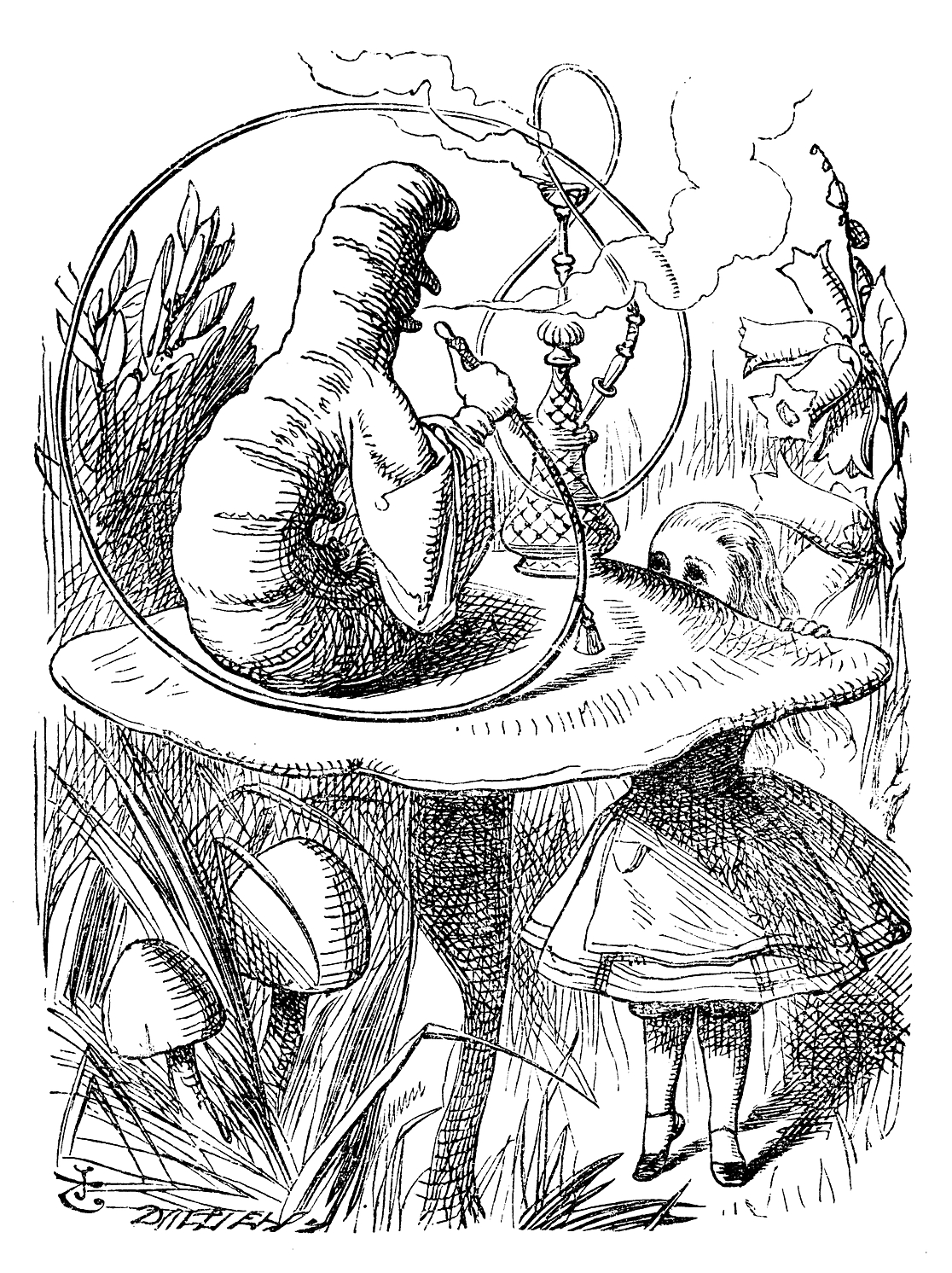Without question, my mother’s favorite books would be Alice’s Adventures in Wonderland and the sequel Through the Looking-Glass, and What Alice Found There .
She read them to us when we were young, but they defy a classification as books for children. The books were written by Charles Lutwidge Dodgson (pen name Lewis Carroll) who was a master of word play, logic and fantasy. The 92 illustrations by John Tenniel embody a style he called “grotesque” suggesting that the real world had ceased to be reliable. For example a hookah smoking Caterpillar is something that one would never encounter in real life.

By Sir John Tenniel – Alice’s Adventures in Wonderland (1865), Public Domain, Link
Movie Adaptations
My mother and I are in agreement that movie adaptations of the Lewis Carroll stories have failed. The most famous of these being the 1951 Walt Disney version . I enjoyed it as a child as a cartoon, but later after revisiting the books, I discovered how much was missing as a result of “Americanizing” the story. The books have a dreamlike logic that doesn’t translate very well to a cinematic treatment.
Alice Entering the Looking Glass
Of the two books, my favorite is Through the Looking Glass, and What Alice Found There. I was intrigued by the idea of a mirror as a portal to another world where everything is reversed. Alice speculates about the Looking -glass world with these words to her cat.
How would you like to live in Looking-glass House, Kitty? I wonder if they’d give you milk in there? Perhaps Looking-glass milk isn’t good to drink— Lewis Carroll
In fact it would not be a good idea to drink Looking-glass milk or eat Looking-glass food. A number of organic compounds have identical chemical formulas but distinct arrangement of their atoms. These are called isomers. If they are mirror images of each other it is called stereoisomerism. These mirror compounds have different biological effects. For example the chemical carvone has a mirror image. One form can be found in Caraway seeds, the other in Spearmint leaves. Same chemical but different smell and taste.

By John Tenniel – Through the Looking-Glass, Public Domain, Link
After Alice enters the Looking-Glass she discovers a book with the poem Jabberwocky which is printed as a mirror image. I was so intrigued with reading this in front of the mirror that I memorized the first stanza which I can still recite. This is the entire poem:
Jabberwocky
BY LEWIS CARROLL’Twas brillig, and the slithy toves Did gyre and gimble in the wabe:All mimsy were the borogoves, And the mome raths outgrabe. “Beware the Jabberwock, my son! The jaws that bite, the claws that catch!Beware the Jubjub bird, and shun The frumious Bandersnatch!” He took his vorpal sword in hand; Long time the manxome foe he sought—So rested he by the Tumtum tree And stood awhile in thought. And, as in uffish thought he stood, The Jabberwock, with eyes of flame,Came whiffling through the tulgey wood, And burbled as it came! One, two! One, two! And through and through The vorpal blade went snicker-snack!He left it dead, and with its head He went galumphing back. “And hast thou slain the Jabberwock? Come to my arms, my beamish boy!O frabjous day! Callooh! Callay!” He chortled in his joy. ’Twas brillig, and the slithy toves Did gyre and gimble in the wabe:All mimsy were the borogoves, And the mome raths outgrabe.

By John Tenniel – http://www.alice-in-wonderland.net/resources/analysis/poem-origins/jabberwocky/
Copied from English Wikipedia., Public Domain, Link
I’ve spent a fair amount of time in my personal Looking-glass world. In my teens I convinced my cousins to call me Nhoj, a name they still use. I had a reel-to-reel tape recorder and discovered by twisting the tape a turn I could play music backwards. Surprisingly the melody is different but just as pleasing. I wasn’t alone with these experiments, reverse tape effects were used by many rock musicians in the 1960s.
I’ve used mirrors and digital mirror effects in my photography. I went to the trouble to disassemble our broken projection television to retrieve a front facing mirror which I used to photograph the gills of mushrooms. With software it is possible to create interesting mirrored abstracts.


Life, What is it but a dream?
Through the Looking Glass ends with the poem. Isn’t it fitting that the last line is “Life, What is it but a dream?”.
A boat beneath a sunny sky,
Lingering onward dreamily
In an evening of July —Children three that nestle near,
Eager eye and willing ear,
Pleased a simple tale to hear —Long had paled that sunny sky:
Echoes fade and memories die.
Autumn frosts have slain July.Still she haunts me, phantomwise,
Alice moving under skies
Never seen by waking eyes.Children yet, the tale to hear,
Eager eye and willing ear,
Lovingly shall nestle near.In a Wonderland they lie,
Dreaming as the days go by,
Dreaming as the summers die:Ever drifting down the stream —
Lingering in the golden gleam —
Life, what is it but a dream?


Discover more from My Strange Life
Subscribe to get the latest posts sent to your email.
